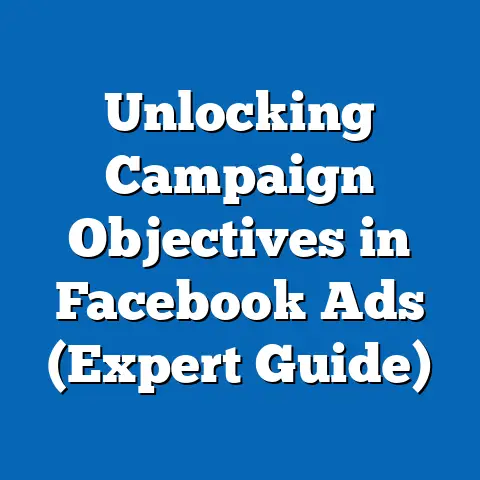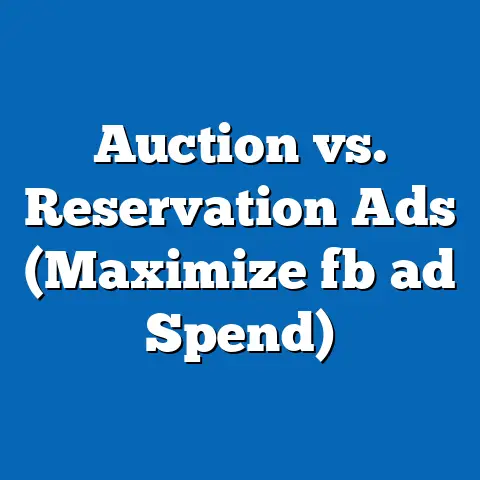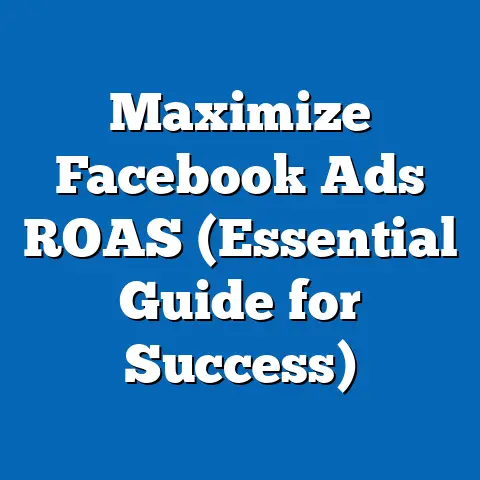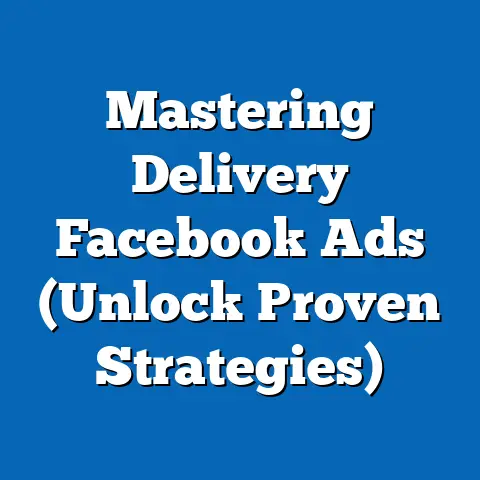Affordable Facebook Ad Strategies (Cost-Saving Insights)
I’ve seen firsthand how intimidating Facebook advertising can seem, especially for small business owners and entrepreneurs who are just starting out. The sheer volume of options, the constantly changing algorithm, and the potential for wasted ad spend can be overwhelming. It’s easy to feel like you need a massive budget to even make a dent in the competitive landscape.
The truth is, you don’t! I’ve spent years helping businesses of all sizes navigate the world of Facebook ads, and I’ve learned that smart strategy trumps deep pockets every time. In this article, I’m going to share some of the most effective cost-saving insights I’ve gathered along the way. We’ll explore everything from understanding the fundamentals of Facebook advertising to crafting compelling ad content and leveraging organic reach to amplify your message. My goal is to equip you with the knowledge and tools you need to run successful Facebook ad campaigns without breaking the bank.
Let’s face it: advertising costs on social media are climbing. According to recent reports, the average cost-per-click (CPC) on Facebook has increased by over 30% in the last year alone. This means that businesses are paying more to reach the same audience, putting pressure on already tight marketing budgets. For smaller businesses, this can feel like an insurmountable challenge. But don’t despair! By implementing smart, strategic approaches, you can cut through the noise and achieve remarkable results, even with a limited budget.
Understanding Facebook Ads
Before diving into cost-saving strategies, it’s crucial to understand the fundamentals of Facebook advertising. Facebook offers a variety of ad formats, each designed to achieve different objectives. These include:
- Image Ads: These are simple yet effective ads that feature a single image and accompanying text. They’re great for showcasing products or services and driving traffic to your website.
- Video Ads: Video ads are more engaging than image ads and can be used to tell a story, demonstrate a product, or share a testimonial.
- Carousel Ads: Carousel ads allow you to display multiple images or videos in a single ad, each with its own headline, description, and link. This format is ideal for showcasing a range of products or highlighting different features of a single product.
- Collection Ads: Collection ads are designed for e-commerce businesses and allow users to browse and purchase products directly from the ad.
One of the biggest advantages of Facebook advertising is its powerful targeting capabilities. You can target users based on demographics (age, gender, location), interests, behaviors, and even custom audiences that you upload yourself. This level of granularity allows you to reach the most relevant consumers for your products or services, maximizing the effectiveness of your ad spend.
The Facebook Ads Manager is your central hub for creating, managing, and analyzing your ad campaigns. It provides a wealth of data and insights that you can use to optimize your campaigns and improve performance. Some key metrics to track include:
- Cost Per Click (CPC): The amount you pay each time someone clicks on your ad.
- Click-Through Rate (CTR): The percentage of people who see your ad and click on it.
- Conversion Rate: The percentage of people who click on your ad and complete a desired action, such as making a purchase or filling out a form.
- Return on Ad Spend (ROAS): The amount of revenue you generate for every dollar you spend on advertising.
Understanding these metrics is essential for evaluating the performance of your campaigns and identifying areas for improvement. Without a solid grasp of these fundamentals, it’s easy to waste money on ineffective ads. The goal is to make informed decisions based on data, not just gut feeling.
Takeaway: Familiarize yourself with the different types of Facebook ads, targeting options, and key metrics. This foundational knowledge is essential for creating cost-effective campaigns.
Setting a Realistic Budget
One of the most common mistakes I see businesses make is setting an unrealistic budget for their Facebook ad campaigns. It’s tempting to throw a small amount of money at a campaign and hope for the best, but this rarely yields results. To achieve meaningful results, you need to establish a budget that aligns with your business goals and allows you to gather enough data to optimize your campaigns.
So, how do you determine a realistic budget? Here are a few factors to consider:
- Business Size: Larger businesses with established brands can typically afford to invest more in advertising than smaller businesses or startups.
- Industry Benchmarks: Research industry benchmarks for advertising spend to get a sense of what other businesses in your niche are spending.
- Target Audience: The size and characteristics of your target audience will influence the cost of your campaigns. Larger, more competitive audiences will generally require a higher budget.
- Business Goals: What are you hoping to achieve with your Facebook ad campaigns? Are you looking to generate leads, drive sales, or increase brand awareness? Your budget should be aligned with your objectives.
I often recommend starting with a smaller budget and gradually scaling up as you see results. This allows you to test different strategies and optimize your campaigns without risking a large amount of money upfront. You can choose between a daily budget, which is the average amount you’re willing to spend each day, or a lifetime budget, which is the total amount you’re willing to spend over the duration of the campaign.
Experimenting with both daily and lifetime budgets is worthwhile. I’ve found that daily budgets can be more predictable, while lifetime budgets offer more flexibility, especially when running ads for specific events or promotions.
Takeaway: Establish a realistic budget based on your business size, industry benchmarks, target audience, and business goals. Start small, test different strategies, and scale up as you see results.
Targeting the Right Audience
Targeting the right audience is arguably the most important factor in reducing ad costs. If you’re showing your ads to people who aren’t interested in your products or services, you’re essentially throwing money away. Facebook offers a wealth of targeting options that allow you to reach the most relevant consumers for your business. These include:
- Demographics: Target users based on age, gender, location, education, and other demographic factors.
- Interests: Target users based on their interests, hobbies, and passions.
- Behaviors: Target users based on their online behavior, such as their purchase history, device usage, and travel habits.
- Custom Audiences: Upload your own customer data (e.g., email addresses, phone numbers) to create custom audiences that you can target with your ads.
- Lookalike Audiences: Create lookalike audiences based on your existing customers or website visitors. Facebook will identify users who share similar characteristics and behaviors, allowing you to reach new potential customers.
Retargeting campaigns are particularly effective for reducing ad costs. Retargeting involves showing ads to people who have already interacted with your business, such as visiting your website or engaging with your content on social media. These users are already familiar with your brand and are more likely to convert.
I’ve found that focusing on niche markets and underserved demographics can also be a great way to reduce ad spend. By targeting a smaller, more specific audience, you can often achieve higher conversion rates at a lower cost.
Takeaway: Utilize Facebook’s audience insights and custom audience features to reach the most relevant consumers. Leverage retargeting campaigns and lookalike audiences to maximize efficiency.
Crafting Compelling Ad Content
Even with the best targeting in the world, your ads won’t be effective if the content isn’t engaging and compelling. Your ads need to grab attention, clearly communicate your value proposition, and inspire action. Here are a few elements that make an ad successful:
- Attention-Grabbing Visuals: Use high-quality images or videos that are visually appealing and relevant to your target audience.
- Clear and Concise Messaging: Get straight to the point and clearly communicate the benefits of your products or services.
- Strong Calls to Action: Tell people exactly what you want them to do, whether it’s visiting your website, making a purchase, or filling out a form.
A/B testing is a powerful technique for optimizing your ad content. A/B testing involves creating multiple versions of an ad with slight variations (e.g., different headlines, images, or calls to action) and then testing them against each other to see which performs best. This allows you to identify the elements that resonate most with your target audience and improve the effectiveness of your ads over time.
I once worked with a client who was struggling to generate leads through their Facebook ad campaigns. We decided to A/B test different headlines and found that a headline that focused on the specific benefits of their product (rather than just a general description) increased their lead generation rate by over 50%.
Takeaway: Create engaging and high-converting ad content with attention-grabbing visuals, clear messaging, and strong calls to action. Use A/B testing to optimize your ads and find what resonates best with your target audience.
Leveraging Organic Reach Alongside Paid Ads
While paid advertising can be a powerful tool for reaching new customers, it’s important to remember that organic reach is still valuable. Building a strong community and engaging with your followers can reduce your reliance on paid advertising and help you amplify your message without additional spending.
Here are a few strategies for leveraging organic reach alongside paid ads:
- Create Shareable Content: Produce content that is informative, entertaining, or inspiring, and that people will want to share with their friends and followers.
- Engage with Your Followers: Respond to comments and messages, ask questions, and create polls to encourage interaction.
- Utilize Facebook Groups: Create or join relevant Facebook groups and share your content with members.
I’ve seen businesses build thriving communities around their brand by consistently creating valuable content and engaging with their followers. This not only reduces their reliance on paid advertising but also builds brand loyalty and advocacy.
Takeaway: Integrate organic content strategies with paid ads to reduce your reliance on paid advertising and amplify your message without additional spending. Create shareable content, engage with your followers, and utilize Facebook groups.
Analyzing and Optimizing Campaigns
The final piece of the puzzle is ongoing analysis and optimization of your Facebook ad campaigns. It’s not enough to simply set up your campaigns and let them run. You need to constantly monitor your results, identify areas for improvement, and make adjustments to your targeting, ad content, and bidding strategies.
Key performance indicators (KPIs) to monitor include:
- Impressions: The number of times your ad is shown.
- Reach: The number of unique people who see your ad.
- Clicks: The number of times people click on your ad.
- Cost Per Click (CPC): The amount you pay each time someone clicks on your ad.
- Click-Through Rate (CTR): The percentage of people who see your ad and click on it.
- Conversion Rate: The percentage of people who click on your ad and complete a desired action.
- Return on Ad Spend (ROAS): The amount of revenue you generate for every dollar you spend on advertising.
By tracking these metrics, you can identify which campaigns are performing well and which ones need improvement. You can then make data-driven decisions about how to optimize your campaigns and reduce costs.
For example, if you notice that your CPC is high, you might try adjusting your targeting or improving your ad content. If your conversion rate is low, you might try A/B testing different landing pages or calls to action.
Takeaway: Continuously analyze and optimize your Facebook ad campaigns by monitoring key performance indicators and making data-driven decisions about targeting, ad content, and bidding strategies.
Conclusion
Affordable Facebook ad strategies are not only possible but essential for businesses aiming to thrive in today’s competitive market. By understanding the fundamentals of Facebook advertising, setting a realistic budget, targeting the right audience, crafting compelling ad content, leveraging organic reach, and continuously analyzing and optimizing your campaigns, you can achieve significant results without a hefty investment.
I encourage you to implement the strategies outlined in this article and see for yourself the potential for achieving remarkable results without breaking the bank. The opportunity lies in mastering cost-effective Facebook advertising and leveraging the power of this platform to reach your target audience and grow your business. Don’t be afraid to experiment, test new ideas, and learn from your mistakes. With a little bit of effort and a strategic approach, you can unlock the full potential of Facebook advertising and achieve your business goals.




